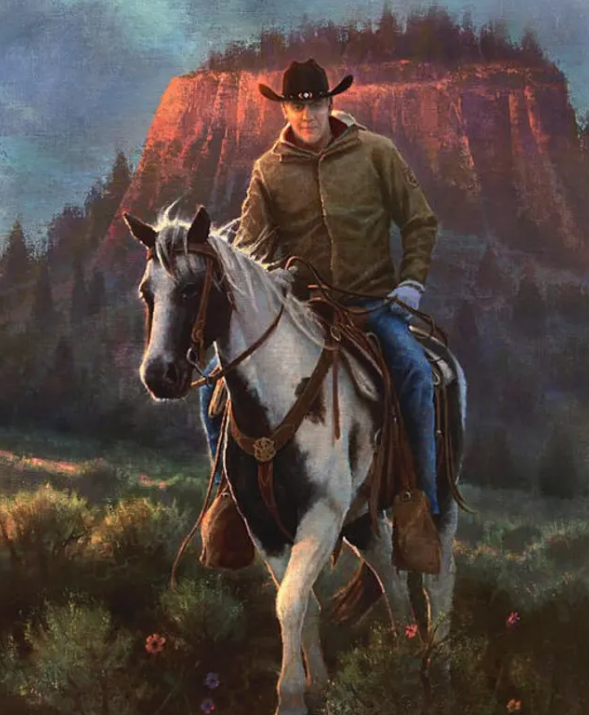WASHINGTON — He came into his post as secretary of the U.S. Department of the Interior riding a borrowed horse named Tonto through the streets of Washington, D.C.

He left his post in December 2018 while under a dozen investigations on his conduct while serving as Interior secretary, including a question about a land deal involving a foundation he led.
Former Interior Secretary Ryan Zinke’s official portrait was unveiled on Wednesday in a ceremony at the Interior Department with him riding a black and white horse with a lot of symbolism in the background. The unveiling was part of a customary ritual to hang portraits of former Interior secretaries in the building that houses the Interior Department.
Painted by Montana artist Brent Cotton, the portrait shows Zinke riding a horse with Bears Ears National Monument in the background. Zinke visited the national monument in 2017, the same year he worked vigorously to reduce the size of the Bear Ears to the dismay of five American Indian tribes who maintain the butte is sacred ceremonial land to their tribal citizens.
Zinke pushed the national monument reduction so that the land could be used for oil, gas and mining exploration. Upon Zinke’s recommendation, President Donald Trump reduced the 1.35-acre Bears Ears boundary by 85 percent and thereby lifted the restrictions on previously protected lands.
The portrait caught the attention of tribal officials and Rep. Raúl M. Grijalva (D-Ariz.), the chair of the House Natural Resources Committee, whose committee oversees many of the Interior Department’s activities.
He was not happy with the portrait depiction.
“Former Secretary Ryan Zinke left office under legal investigation, and his new portrait is entirely consistent with his smug, unethical, condescending tenure at the Interior Department. Setting his formal portrait at Bears Ears National Monument, which he happily dismantled despite the wishes of Native Americans around the country, is nothing more than an intentional final insult to tribes he disrespected from the moment he took office. This portrait is a petty monument to a petty man, and we can only look forward to a court ruling that reverses the damage he did to the landscape he has now abused twice.”
Shaun Chapoose, a member of the Ute Indian Tribe Business Committee and representative of the Bears Ears Inter-Tribal Coalition, wasn’t impressed with the Zinke portrait either.
“Zinke’s official portrait is the last gasp of a fading swamp creature,” Chapoose told HuffPost. “He testified to Congress that tribal ‘sovereignty means something’ while he ignored the clear statements of five sovereign tribal governments that the Bears Ears landscape needs and deserves protection.”
Even with his official portrait up in the U.S. Dept. of the Interior, Zinke still faces possible charges arising from the Interior's Office of Inspector General probe. The Inspector General referred the matter to the Justice Department for potential prosecution of conflict of interest laws.
The Interior Department is home to the Bureau of Indian Affairs, Bureau of Indian Education, Office of Special Trustee and Bureau of Land Management.
More Stories Like This
Native News Weekly (August 25, 2024): D.C. BriefsUS Presidents in Their Own Words Concerning American Indians
Happy New Year 2026 from Native News Online
Next on Native Bidaské: Covering Indian Country: Lessons from 2025 & the Road Ahead
The Stories That Started to Define Cultivating Culture in 2025
Help us defend tribal sovereignty.
At Native News Online, our mission is rooted in telling the stories that strengthen sovereignty and uplift Indigenous voices — not just at year’s end, but every single day.
Because of your generosity last year, we were able to keep our reporters on the ground in tribal communities, at national gatherings and in the halls of Congress — covering the issues that matter most to Indian Country: sovereignty, culture, education, health and economic opportunity.
That support sustained us through a tough year in 2025. Now, as we look to the year ahead, we need your help right now to ensure warrior journalism remains strong — reporting that defends tribal sovereignty, amplifies Native truth, and holds power accountable.
 The stakes couldn't be higher. Your support keeps Native voices heard, Native stories told and Native sovereignty defended.
The stakes couldn't be higher. Your support keeps Native voices heard, Native stories told and Native sovereignty defended.
Stand with Warrior Journalism today.
Levi Rickert (Potawatomi), Editor & Publisher

